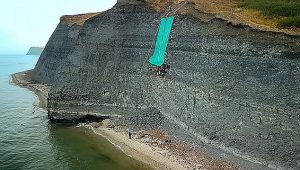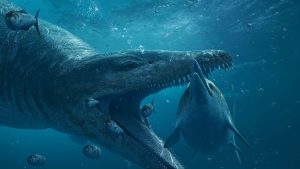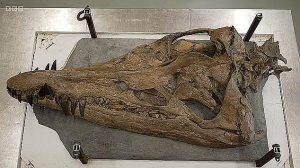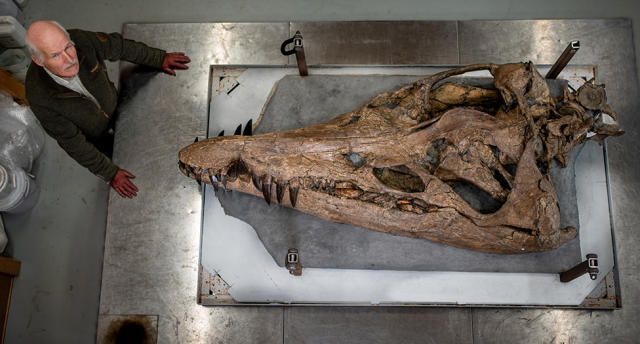A giant sea monster – possibly the most powerful ever discovered – is now on display after being painstakingly dug out of the Jurassic coast over three weeks.
The pliosaur, which had 130 teeth and whose jaws were twice as powerful as a crocodile, was discovered by fossil enthusiast Phil Jacobs, 69, of West Bexington at Kimmeridge, after he found the front of its jaw on the beach.

He called in Dr Steve Etches, who runs a nearby exhibition of more than 2,000 specimens, amassed over three decades.
A massive operation saw Steve and his team slowly chip away around the skull, lodged halfway up the crumbling cliff, using air tools and chisels while suspended on ropes.

Then local farmer, Rob Vearncombe, who does a spot of engineering in his spare time, arrived with a contraption he had devised to get the skull up and out with as little damage as possible.
Looking on for some of the operation was beloved veteran broadcaster Sir David Attenburgh, whose show on the pliosaur was aired on New Year’s Day on BBC1.
The skull alone is almost 7ft long – and the rest of the pliosaur’s body is believed to be lodged in the cliff behind it.
The beast would have lived nearly 150 million years ago and its ridged teeth and powerful jaws enabled it to feed on large prey, disabling and killing in a flash.
Sensors peppered all over its face and a third eye, believed to have had a cornea, combined to make this pliosaur the ultimate killing machine.
Pliosaurs were up to 40 feet long, with four flippers enabling them to power through the water at 10km per hour.

Judyth Sassoon, a pliosaur expert at Bristol University, said it was very likely to be a new species.
The bones suggest the animal was still not fully grown, giving rise to the idea that pliosaurs were much larger than previously thought. Pliosaur bones found earlier suggest that there were larger pliosaurs.
However no skulls for these larger specimens have ever been found, which meant this discovery would enable scientists to find out much more about how the creature hunted. To find a skull with a complete set of teeth is also rare – and from one forming tooth they could see the beast could replace teeth.
n Attenborough and the Giant Sea Monster is on BBC iPlayer.




